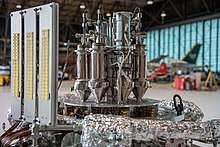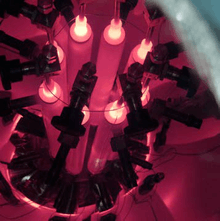Kilopower
| Kilopower Reactor | |
|---|---|
 Prototype NASA 1kW Kilopower nuclear reactor for use in space and planet surfaces | |
| Generation | Experimental |
| Reactor concept | Stirling engine |
| Status | In development |
| Main parameters of the reactor core | |
| Fuel (fissile material) | HEU: 235U |
| Fuel state | Solid (cast cylinder) |
| Primary control method | Boron carbide control rod |
| Neutron Reflector | Beryllium oxide radial reflector |
| Primary coolant | Sodium heat pipes |
| Reactor usage | |
| Primary use | Long-duration space missions |
| Power (thermal) | 4.3–43.3 kWth |
| Power (electric) | 1–10 kW |
| Website |
www |
Kilopower (full name is Kilopower Reactor Using Stirling Technology, or KRUSTY[1]) is an experimental project aimed at producing a new design for nuclear reactors for space travel.[2][3] The project started in October 2015, led by NASA and the Department of Energy’s National Nuclear Security Administration (NNSA).[4] The Kilopower reactors will come in 4 sizes able to produce from one to 10 kilowatts of electrical power (1-10 kWe), continuously for 12-15 years.[5][6] The fission reactor uses uranium-235 to generate heat that is carried to the Stirling converters via passive sodium heat pipes.[7]
Potential applications include nuclear electric propulsion and a steady electricity supply for crewed or robotic space missions that require large amounts of power, especially where sunlight is limited or not available.
Design
A fission reactor that uses uranium-235 in a molybdenum alloy was selected due to its suitability for the application, design simplicity, and its manufacturability at existing facilities.[8] A uranium core has the additional benefit of avoiding uncertainty in the supply of plutonium.[9] The core of the reactor will be of solid, cast uranium-235 alloy surrounded by a beryllium oxide reflector. This reflector focuses neutron emissions and returns their energy back into the core to minimize nuclear gamma radiation which could impair on-board electronics.[10]
The prototype KRUSTY 1 kWe Kilopower prototype reactor weights 134 kg and contains 28 kg of U235. The space rated 10 kWe Kilopower for Mars is expected to mass 226 kg and contain 43.7 kg of U235.[6]
Nuclear reaction control is provided by a single rod of boron carbide which is a neutron absorber that is initially inserted, so that pre-launch radiation is negligible. Once the reactor reaches its destination, the neutron absorbing poison rod is removed to allow the nuclear chain reaction to start.[8] Once the reaction is initiated, it can not be stopped completely, although the depth of insertion provides a mechanism to adjust the heat output from the reactor core to the load demand.
Passive heat pipes filled with liquid sodium then transfer the reactor core heat to one or more Stirling engines, which converts heat into rotary motion that drives a conventional electric generator.[11] The melting point of sodium is 98 °C (208 °F) which means that liquid sodium can flow freely at high temperatures between about 400 and 700 °C (750 and 1,300 °F). Nuclear fission cores typically operate at about 600 °C (1,100 °F).
The reactor is designed to be intrinsically safe in a wide range of environments and scenarios. Several feedback mechanisms are employed to mitigate a nuclear meltdown. The primary method is passive cooling, which requires no mechanical mechanisms to circulate coolant. The reactor design is self-regulating, through design geometry that creates a negative temperature reactivity coefficient.[12]
Testing
A test reactor has been constructed, called KRUSTY or Kilopower Reactor Using Stirling Technology. It is designed to produce up to 1 kilowatt of electric power and is about 6.5 feet tall (1.9 meters).[13] The goal of the KRUSTY experiment is to closely match the operational parameters that would be required in NASA deep space missions[14]. The prototype Kilopower uses a solid, cast uranium-235 reactor core, about the size of a paper towel roll. Reactor heat is transferred via passive sodium heat pipes, with the heat being converted to electricity by Stirling engines. Testing to gain TRL 5 started in November 2017 and continued into 2018.[5] The first tests used a depleted uranium core manufactured by Y-12 National Security Complex in Tennessee. The depleted uranium core is exactly the same material as the regular high-enriched uranium (HEU) core with the only difference being the level of uranium enrichment.[2] The testing of KRUSTY represents the first time the United States has conducted ground tests on any space reactor since the SNAP-10A experimental reactor was tested and eventually flown in 1965.[2]
During November 2017 through March 2018, testing of KRUSTY was conducted at Nevada National Security Site. The tests included thermal, materials, and component validation, and culminated in a successful fission trial at full-power. Various faults in the supporting equipment were simulated to ensure the reactor could respond safely.[3]
The KRUSTY reactor was run at full power on March 20, 2018 during a 28-hour test using a 28 kg uranium-235 reactor core. A temperature of 850 °C (1,560 °F) was achieved, producing about 5.5 kW of fission power. The test evaluated failure scenarios including shutting down the Stirling engines, adjusting the control rod, thermal cycling, and disabling the heat-removal system. A Scram test concluded the experiment. The test was considered to be a highly successful demonstration.[15]
Demonstration using Flattop fissions
The development of Kilopower also included an experiment called DUFF or Demonstration Using Flattop Fissions experiment, which was tested in September 2012 using the existing Flattop assembly as a nuclear heat source. When DUFF was tested at the Device Assembly Facility at the Nevada Test Site, it became the first Stirling engine powered by fission energy and the first use of a heat pipe to transport heat from a reactor to a power conversion system.[16] According to David Poston, the leader of the Compact Fission Reactor Design Team, and Patrick McClure, the manager for small nuclear reactor projects at Los Alamos National Laboratory,[2] the DUFF experiment showed that "for low-power reactor systems, nuclear testing can be accomplished with reasonable cost and schedule within the existing infrastructure and regulatory environment".[16]
 The depleted uranium core, manufactured at Y-12 for the KRUSTY experiment.
The depleted uranium core, manufactured at Y-12 for the KRUSTY experiment. Heat pipes of KRUSTY during an electrical-heating test
Heat pipes of KRUSTY during an electrical-heating test
See also
References
- ↑ Demonstration Proves Nuclear Fission System Can Provide Space Exploration Power. Sean Potter, NASA News. May 2, 2018. RELEASE 18-031.
- 1 2 3 4 Gibson, Marc; Oleson, Steven; Poston, David; McClure, Patrick. "NASA's Kilopower Reactor Development and the Path to Higher Power Missions" (PDF). NASA. Retrieved March 25, 2018.
- 1 2 Jan Wittry, Gina Anderson. "Demonstration Proves Nuclear Fission System Can Provide Space Exploration Power". NASA. Retrieved May 2, 2018.
- ↑ "Kilopower Small Fission Technology (KP)". TechPort.nasa.gov. NASA. 2011-08-09. Retrieved 16 May 2018.
- 1 2 Loura Hall. "Powering Up NASA's Human Reach for the Red Planet". NASA.GOV. NASA. Retrieved November 15, 2017.
- 1 2 Mcclure, Patrick Ray (2017-03-06). "Space Nuclear Reactor Development". Nuclear Engineering Capability Review. LA-UR-17-21904: 16. Retrieved 16 May 2018.
- ↑ "Kilopower Project media slides" (PDF). NASA.GOV. NASA and Los Alamos. Retrieved January 26, 2018.
- 1 2 Gibson, Marc A.; Mason, Lee; Bowman, Cheryl; et al. (June 1, 2015). "Development of NASA's Small Fission Power System for Science and Human Exploration". 50th Joint Propulsion Conference. NASA/TM-2015-218460: 4. Retrieved 16 May 2018.
- ↑ Foust, Jeff (10 October 2017). "Plutonium supply for NASA missions faces long-term challenges - SpaceNews.com". SpaceNews.com. Retrieved 16 May 2018.
- ↑ Szondy, David (May 2, 2018). "NASA successfully tests next-generation space reactor". New Atlas. GIZMAG PTY LTD. Retrieved 12 June 2018.
- ↑ Patrascu, Daniel (3 May 2018). "NASA KRUSTY Nuclear Reactor Could Power Outposts on Mars for Years". autoevolution. SoftNews NET. Retrieved 12 June 2018.
- ↑ "KRUSTY: First of a New Breed of Reactors, Kilopower Part II". Beyond NERVA. beyondnerva. 19 November 2017. Retrieved 16 May 2018.
- ↑ Irene Klotz (June 29, 2017). "NASA to Test Fission Power for Future Mars Colony". Space.com. Retrieved November 15, 2017.
- ↑ Sanchez, Rene (March 2017). "Kilowatt Reactor Using Stirling TechnologY (KRUSTY) Experiment Update Marcy 2017" (PDF). National Criticality Experiments Research Center. Retrieved April 25, 2018.
- ↑ "KRUSTY: We Have Fission! Kilopower part III". Beyond NERVA. beyondnerva. 2 May 2018. Retrieved 16 May 2018.
- 1 2 Poston, David; McClure, Patrick (January 2013). "The DUFF experiment - What was learned?". Nuclear and Emerging Technologies for Space.
External links
- Kilopower NASA web site
- Kilopower: A Gateway to Abundant Power for Exploration on YouTube
- Small Reactor for Deep Space Exploration - Los Alamos National Laboratory on YouTube
- Kilopower Reactor - public presentation in August 2018 on YouTube
- Kilopower - facts
- KiloPower Space Reactor Concept - Reactor Materials Study